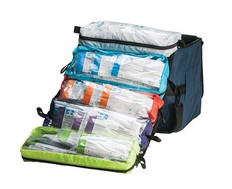

The vast majority of patients with a severe head injury who have a Glasgow Coma Score of eight or less or are in shock will need endotracheal intubation.Īt one time, uncuffed endotracheal (ET) tubes were recommended for infants and small children to avoid pressure-induced damage to the trachea. It's critically important to select the appropriate device - inserting a too-large oral airway can cause more obstruction. But the size of the device can also be determined simply by measuring from the corner of the patient's mouth to the mandible. The Broselow tape - a universal weight-based measure - can be used to calculate the right-size oral airway in kids up to 12 years old.

If ventilation is inadequate with the BVM, an adjunct oral airway device can help keep the airway open. Masks are sized for newborns, infants and children choosing the appropriate size and applying it properly are essential to create a better seal and more effective ventilation as well as to reduce the risk of aspiration.Ĭomparison studies have consistently shown that a two-person BVM technique, in which one rescuer squeezes the bag while the other uses both hands to hold the mask, provides better ventilation than when the mask is placed by a single provider.

Both provide ventilation and oxygenation until a more-definitive airway can be established or when a definitive airway isn't possible. Blow by or bag-valve-mask (BVM)Įvery child with significant traumatic injuries should receive oxygen in the pre-hospital setting, which may first be administered by blow by or bag-valve-mask (BVM). Gentle suctioning of the mouth and upper airway helps clear away blood, vomit and other secretions. This opens the airway by moving the tongue away from the pharynx. The most basic technique to ensure a patent airway in traumatic injury is the jaw thrust, which is performed by grasping the lower jaw on both sides and lifting it straight forward. The steps in managing the airway of a child with serious head trauma include: Jaw thrust and suction Airway sizeĬhildren have smaller airways in general - about the diameter of their small finger - which are harder to visualize and more prone to obstruction from relatively small amounts of blood or mucus. This can worsen airway obstruction when the neck is hyperextended. Located at the level of the first or second cervical vertebra, the pharynx is higher and more anterior in infants and children than in adults. Kids have relatively large tongues and small mouths the tongue falling back against the pharynx is one of the most common causes of airway obstruction. When these aren't available, laying a rolled towel or blanket under the child's shoulders and hips elevates the body, protecting the cervical spine in the neutral position and opening the airway. Some but not all ambulances carry pediatric backboards that have a cut-out for a child's large occiput. This flexes the neck and compromises the airway." "This is important because when a child with a traumatic head injury is placed on a backboard with a neck brace by pre-hospital providers, the cervical spine isn't in a neutral position the occiput is so big, the head rolls forward. "Infants and younger children have large heads relative to their body," he explains.

Dean Potter Jr., M.D., a pediatric surgeon at Mayo Clinic's campus in Rochester, Minnesota, anatomical differences to consider in kids include: Head size


 0 kommentar(er)
0 kommentar(er)
